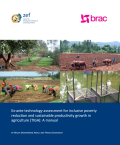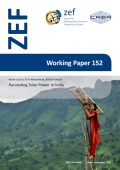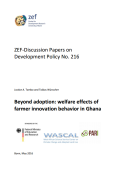
In June 2014 the Government of India launched the Power for All initiative with an aim to provide 24x7 power across the country by 2019. Subsequently, a sub-committee of the Forum of Regulators (FoR) prepared a national roadmap for the initiative. FoR defined the scope of the initiative to include reliable 24x7 power supply to domestic, industrial, and commercial consumers, power supply to irrigation pump sets for 8 to 10 hours, and access to all connected households by 2018–19. The roadmap made recommendations for fuel supply, generation, transmission and distribution sectors, and demand-side management. In view of the federal structure of India’s power sector, a key recommendation of the FoR study was to formulate state-level strategies to meet the objectives of 24x7 Power for All.

This Technical Note provides a summary of the key elements and design features of 11 different carbon offset programs. It discusses the essential differences and similarities between programs, and discusses how these programs address key issues, such as: efficiency, environmental integrity, applicability, and transaction costs. It does not evaluate the implications of the different design features. This note may be useful for countries that are contemplating different designs of carbon offset programs and other crediting mechanisms.

The manual presented here is based on the experience and draw out the collected lessons learnt with regard to the design and implementation of TIGA project in the South Asia and Sub-Saharan Africa. As such, this builds on and expands existing guidelines and documentation for agricultural technology assessment. It adds the perspective of technology assessment of including the cross section of segments of the rural poor characterized by varying degrees of overlapping human capabilities and agro-ecological potentials rather than the technology-driven approaches that tend to favor those with better adoption capabilities. The manual also gives the reader a well-documented experience of bottom-up approach for technology assessment.

Prime Minister Narendra Modi has set an ambitious target of 100,000 MW of solar power capacity to be achieved by 2022, when India celebrates 75 years of her independence. This is a grand vision for ushering in a sort of revolution in clean energy in India in the next six years. In a country that generates more than 60 percent of its power by burning coal, and where air quality is fast worsening in several Indian cities, the need for clean energy cannot be overstated. Interestingly, Prime Minister Modi has also set another ambitious target of doubling farmers'
incomes by 2022!
The uppermost question in everyone's mind is: can these targets be achieved by 2022? This is particularly so when the current solar power capacity in the country has just touched 8000 MW by July end, 2016, and no country in the world has such an ambitious target as India has set out for 2022. On farmers' real incomes, the compound annual growth rate (CAGR) in the recent past (FY2003 to FY 2013) has been mere 3.5 percent; and doubling these incomes by 2022 would mean increasing this CAGR from 3.5 percent to more than 12 percent.

With numerous challenges hindering smallholders’ adoption of externally developed technologies, it is often argued that farmer innovation can play an essential role in rural livelihoods. Yet a rigorous assessment of the impact of farmer innovation is lacking. We address this issue by analysing the effect of farmer innovation on household welfare, measured by income, consumption expenditure, and food security. Using household survey data from northern Ghana and applying endogenous switching regression, we find that farmer innovation significantly increases household income and consumption expenditure for innovators. It also contributes significantly to the reduction of food insecurity among innovative households by increasing household food consumption expenditure, decreasing the duration of food shortage, and reducing the severity of hunger. However, we find that the positive productivity and income effects of farmer innovation do not significantly translate into nutritious diet, measured by household dietary diversity.
